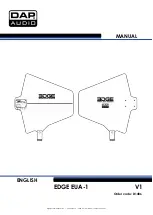
16
1.6.4.7.1
A bearing pressed into the moving mounting plate travels up and down on a guide shaft
pressed into the waveguide housing. This ensures that the vanes do not tilt in the waveguide. A
guide cantilevered from the mounting plate rides on a post located under the motor to keep the
moving plate and vanes from rotating about the guide shaft, ensuring that the vanes are properly
oriented in the waveguide.
1.6.4.7.2
Figure 1-3 is a schematic diagram that includes both the normal polarizer (8A2A1) and the
passive polarizer (8A2A2), together with the interconnection provided by cables CA1 and CA2. The
circuit configuration is shown for circular polarization. The circular select signal (220 Volts AC)
applied at 8A2A1-.11-L and 8A2A2-J1-L has already driven both motors to the point at which the
switch cam removes power through switches 8A2A1-S4 and 8A2A2-S4. At the same time, status
ground (SG) signal at 8A2A1-J1-E and 8A2A2-J1-E is applied through switches 8A2A1-S2 and
8A2A2-S2 respectively to produce the Circular Status for Low-beam (CSL - for normal polarizer at
8A2AI-Jl-H) and the Circular Status for High-beam (CSH - for the passive polarizer at 8A2A2-J1-
H). At this time, the vanes are inserted at maximum depth in the square waveguide section and
operation is in the circular polarization mode as indicated at the system control panels.
1.6.4.7.3
If a linear select signal (220 Volts AC) is now applied at the polarizers both motors will run
once more and drive to the linear positions of the cams. When each polarizer reaches its preset
position, the switch cam will operate S3 to remove power from the motor and Si to complete the
readback circuit. Thus,
a.
motor power will be removed from parallel-connected motor circuits;
b.
status ground (SG) signal at 8A2A1-J1-E and 8A2A2-J1-E is applied through switches
8A2A1-S1 and 8A2A2-S1 respectively to produce the Linear Status for Lowbeam (LSL - for
normal polarization at 8A2A1-.11-F) and the Linear Status for Highbeam (LSH - for the
passive polarizer at 8A2A2-J1-F);
c.
vanes will be inserted at minimum depth in the square waveguide section;
d.
operation will be in linear polarization mode, as indicated at the system control panels. A
circular select signal applied now at 8A2A1-.11-L will cause the motor to drive once more to
the circuit configuration shown in the schematic diagram.
1.6.4.7.4
A capacitor connected across the ac input for each motor provides phase shift for the motor
winding. Capacitor C2 and back-to-back zener diodes that are connected across the motor
windings reduce the generation of transient spikes when the motors are switched off.
Summary of Contents for 174100
Page 17: ...17 Figure 1 1 Typical Pattern Azimuth...
Page 18: ...18 Figure 1 2 Typical Pattern Elevation...
Page 19: ...19 Figure 1 3 Polarizer Schematic...
Page 20: ...02 08 2016 SDR ASR11 052 TI 6310 59 20...
Page 22: ...22 Figure 3 1 Complete Antenna Installation...
Page 23: ...23 Figure 3 2 Shipping and Support Stand...
Page 33: ...33 Figure 3 3 Base Interface Kit PSR Base Assembly...
Page 35: ...35 Figure 3 4 Fixed Feeds Unit Installation...
Page 42: ...42 Figure 3 5 Ladder Kit Installation...
Page 45: ...45 Figure 3 6 PSR SSR Interface Mount Installation...
Page 49: ...49 Figure 3 7 Antenna Lift Kit Installation...
Page 54: ...54 Figure 3 8 Waveguide Installation...
Page 55: ...55 Figure 3 9 Waveguide Hanger Installation...
Page 61: ...61 Figure 3 11 SSR Coaxial Cable Installation and Tilt Scale Bracket Installation...
Page 65: ...65 Figure 3 12 Antenna Feedhorn and Tilt Alignment Contour Cheek...
Page 66: ...66 Figure 3 13 Antenna Azimuth Alignment...
Page 67: ...67 Figure 3 14 Counterweight Installation...
Page 81: ...02 08 2016 SDR ASR11 052 TI 6310 59 75 This Page Intentionally Left Blank...
Page 82: ...76 Figure 4 1 Polarizer...
Page 83: ...77 Figure 4 2 Polarizer Motor Replacement...
Page 87: ...81 Figure 5 1 Test Antenna Kit...
















































